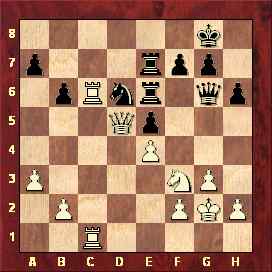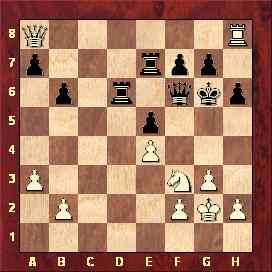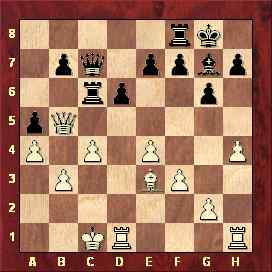 | |
| _ | |
| Online Database | |
| Player Database | |
| ChessBase World | |
| Birthday Calendar | |
| New Products | |
| Shop | |
| Puzzle | |
| Tactics | |
| Support | |
| T-Notes | |
| Contents | |
| Contact | |
A new conception - Chess Tiger 14.0
Peter Schreiner introduces the new ChessBase engine
 The
program Chess Tiger certainly belongs to the elite of today's "electronic
grandmasters". It is highly esteemed in the computer chess community,
with its predecessor occupying place three in the Swedish SSDF computer
chess rankings. The author, Christophe Théron (right), lives on
the Caribbean island of Guadeloupe and has been working since 1979 on
his program. In the last two years the young Frenchman has always achieved
excellent results in the important tournaments, and his Chess Tiger even
managed to top the Swedish list on one occasion.
The
program Chess Tiger certainly belongs to the elite of today's "electronic
grandmasters". It is highly esteemed in the computer chess community,
with its predecessor occupying place three in the Swedish SSDF computer
chess rankings. The author, Christophe Théron (right), lives on
the Caribbean island of Guadeloupe and has been working since 1979 on
his program. In the last two years the young Frenchman has always achieved
excellent results in the important tournaments, and his Chess Tiger even
managed to top the Swedish list on one occasion.
When looking at the playing style of the top programs today one can easily conclude that differences in practical playing strength have become very small and only the playing style can be considered the distinguishing factor. This is especially true of the new Chess Tiger 14.0, which has the potential of becoming a dominating force in computer chess. Its author Christophe Théron is currently on a creative peak, and his efforts have the additional advantage of providing the user with a second very strong engine called Gambit Tiger 2.0. Both programs run under the Fritz interface and can be used as an analysis engine in ChessBase 7 or 8 as well. The price for Chess Tiger 14.0 and Gambit Tiger 2.0, which are delivered on a single CD with the latest Fritz interface, is DM 99.90 (around $45).
Chess Tiger 14.0
Describing the typical playing style of Chess Tiger 14.0 is fairly simple. It is an extremely solid program, very active, with good positional understanding and an excellent evaluation function. In games against other chess engines it is ruthlessly efficient in capitalising on microscopic positional inaccuracies by the opponent. Its superiority in this area has become a problem for the competition.
A clear weakness in earlier versions was to be found in the endgame. Chess Tiger did not use the Nalimov endgame tablebases, because its author was wont to slow down his program with hard disk accesses. This has been changed in the current version, which has received a very efficient implementation of tablebase lookups – so much so that there is a net increase of search speed in spite of the hard disk activity. Here is an elementary example:

This position, with Black to play, is contained in the endgame database of Eugene Nalimov. Earlier versions of Chess Tiger would compute for any length of time and come up with 1...Kb2?, which only draws, while the new program finds the only winning move, 1...Ka3!, in 0:00 seconds, announcing mate in 22 and playing all the rest of the moves in zero seconds each. Here are the main lines: 1...Ka3! 2.g4 Kb4 3.g5 Kc5 4.g6 Kd6 5.g7 Rb8 6.Kf5 Ke7 7.Kg6 Re8 8.Kh7 Kf7 9.Kh6 Re6+ 10.Kh7 Rg6 wins, whereas 1...Kb2! 2.g4 Kc3 3.g5 Kd4 4.g6 Rb8 5.Kf5 Kd5 6.g7 Kd6 7.Kf6 Rg8 8.Kf7 is only a draw.
Apart from the solid and balanced playing strength in all parts of the game it is especially the attacking play that impresses us in the new program. It is obvious that Chess Tiger knows a large number of basic attacking strategies. Let us take a look at a typical breakthrough in a practical game by Anatoly Karpov:
Karpov - Uddenfeldt
Skopje (ol) 1972

Position after 16...Qc7-b7
Black is behind in development and also has failed to castle. Karpov makes use of these facts and launches his attack with the thematic 17.f5!, winning the game in the process. For most computer programs this motif is a complete mystery, but not for Chess Tiger 14.0, which needs just 26 seconds (on a PIII/800 MHz) to find the key move and play it with a high positive score.
Gambit Tiger 2.0
The engine Gambit Tiger 2.0, which is also included on the CD, turns out to be an even more vigorous attacker. It will never leave out an opportunity to play aggressively, and this is bound to cause a fair amount of turmoil in the chess scene. The Gambit Tiger style produces a wealth of surprising speculative sacrifices, which makes it very difficult to handle by human opponents. It is also very difficult to use the well-known anti-computer playing strategies against this program. The following position will give you a feel for the sharp and risky style which gave Gambit Tiger 2.0 its name:
Duras - Barasz
Breslau 1912

Position after 34...Qf6-g6
Duras continued with the aggressive exchange sacrifice 35.Rxd6!! The forced continuation is 35...Rxd6 36.Rc8+ Kh7 37.Qa8 Qf6 (37...Qh5 38.Nh4!; 37...Qg4 38.Nh4!) 38.Rh8+ Kg6

The exchange sacrifice has to be calculated up to this position in order to get a positive evaluation. The bad position of the black king guarantees White's victory in the game, which continued with 39.Qg8 (39.Nh4+ also wins) 39...Rd3 40.Nh4+ Kg5 41.Nf5 Re6 42.h4+ Kg4 43.Nxh6+ Kh5 44.Nxf7+ Kg4 45. Nh6+ Kh5 46.Nf5+ Kg4 47.Rh7 Re7 48. Nh6+ Kh5 49.Nf7+1-0.
The new Fritz engine Gambit Tiger 2.0 needs 21 seconds (on a PIII/800 MHz) in order to find the beautiful exchange sacrifice that wins the game.
In recent times we have become used to the fact that computers are superior to human beings in the tactical sector, and analysing games even at the highest levels will reveal a number of tactical inaccuracies. But in one area human beings are clearly superior - creative and strategic planning. But here, too, Gambit Tiger displays exceptional qualities which leave a greater impression on experts than its outrageous thirty-move mate announcements. Here's an example:
Ivkov - Larsen
Hoogoven Turnier Beverwijk 1964

Position after 20.b2-b3
If you examine this position critically it becomes clear that White has some weaknesses. His king is out in the open, and the black bishop on g7 is a giant. Larsen found a very elegant continuation that capitalises on White's positional problems: 20...Rc5! Powerful play, with the idea of increasing the effect of the Bg7 by getting rid of its counterpart on e3. Black dominates the dark squares and has the very important centre square d4 at his disposal.
Gambit Tiger 2.0 is the only commercial program I know that can solve the positional problem in a reasonable amount of time. In less than a minute it finds the exchange sacrifice and sticks with it after that, while its evaluation continues to rise. Larsen's winning plan became obvious after the moves 21.Bxc5 dxc5 22.Rd5 e6 23.Qxc5 Qg3 24.Rg5 Qf4+ 25.Kc2 f5, which Tiger of course also plays.
Conclusion
Although both engines play completely different styles they are almost
exactly equal in playing strength. The character of Chess Tiger 14.0
is clearly positional and solid, while Gambit Tiger 2.0 displays
a much riskier style, while retaining a solid positional basis. Both engines
are not primarily interested in complicated tactical skirmishes, they
mainly strive for initiative. Looking at results that have been published
so far we must conclude that both engines will occupy a top place in the
computer chess rankings. For tournament players it is very exciting to
analyse games with two so powerful engines which each has a completely
different approach to the position. This is enhanced by the fact that
Christophe Théron has implemented the multi-variation mode in Fritz,
which means that you can see a list of alternative lines and evaluations
in the search window. All this makes the two Tiger programs ideal partners
for you training and analysis sessions.

